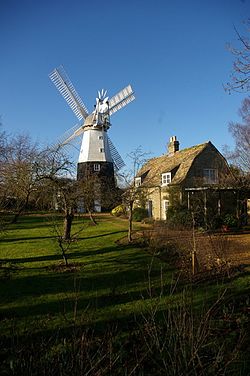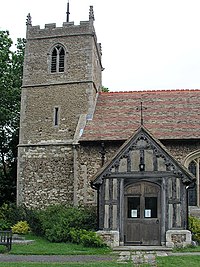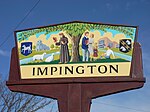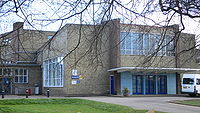Impington
| Impington | |
| Cambridgeshire | |
|---|---|
 Impington Windmill | |
| Location | |
| Grid reference: | TL437637 |
| Location: | 52°15’13"N, -0°6’15"E |
| Data | |
| Post town: | Cambridge |
| Postcode: | CB24 |
| Dialling code: | 01223 |
| Local Government | |
| Council: | South Cambridgeshire |
| Parliamentary constituency: |
South Cambridgeshire |
Impington is a village in Cambridgeshire, just to the north of Cambridge, and separated from its northern suburbs by the A14 trunk road.
Adjoining Impington is Histon, and over the years the two villages have grown and entwined together, to such an extent that many villagers today do not know where one ends and the other begins.
The International Whaling Commission is based in Impington: comfortably out of sight of the sea perhaps.
Name
The name of the village has been recorded in various guises. In the Domesday Book it was recorded as Epintone,[1] but it has also been recorded as Empinton, Ympiton, Impinton, Hinpinton and Impynton.[2]
The name is Old English and named from a clan named perhaps Impingas or Empingas, so perhaps "Impa's folk's village".[3] However given the Domesday Book spelling Epin-, this might also be the same meaning as in 'Epping', suggested to mean a "platform or raised place".
Churches
There is one church in Impington, St Andrew's, but between them the two villages of Histon and Impington have five churches with six congregations:
- Church of England:
- St Andrew, Impington
- St Andrew, Histon
- Baptist: Histon Baptist Church
- Independent evangelical: New Life Church (meets at the Baptist Church)
- Methodist: Histon Methodist Church
- Salvation Army: Histon Salvation Army Church
All the congregations work closely together through the Histon and Impington Council of Churches.
St Andrew's, Impington

The original church was built about 1130 and appears to have been dedicated originally to St Æthelthryth (Etheldreda). Its first use was not as a church for the parish but to transcribe books for the prior of Ely. The first vicar was not appointed until the 13th century and since then it has been mainly rebuilt in the 14th and 15th centuries. The church was built of field stones and masonry rubble and the stones from the original building can still be seen.[4]
The original churchyard wall was built in 1614 but this crumbling wall was replaced in 2005 after a £50,000 grant from the Heritage Lottery Fund.[5] The tower contains three bells at least two of which date from the 15th century.
History
Early history
Some of the track ways that pass though these villages are believed to be prehistoric. Flint tools have been dug up in and around the area and aerial photographs show evidence of ancient settlements including Iron Age and Roman. Pieces of Roman pottery have been found in the area.
The earliest part of Impington to be inhabited is near the junction of Cambridge Road and Arbury Road. In this location there is a large ancient settlement - thought to have been built by the Ancient Britons. The settlement was taken over by the Romans when they invaded Britain. There are several roads in Impington that are thought to be based on Roman roads.
William the Conqueror is recorded as judging in a dispute over the town of Epintone between the Sheriff of Cambridge and the church.[6]
Founding the village

The first area of settlement in the village was to the extreme south of the current village, close to current road junction of the Cambridge and Kings Hedges Road (once called Arbury Camp). The main evidence left today of the Roman occupation is the Roman road, Akeman Street (known locally as the Mereway),[7] this cuts though the edge of Impington and heads for The Fens, this route had fallen into disuse by the 11th century.
The first mention of Impington by name was in the year 991 when the Brithnoth left the village in the charge of the Abbot of Ely, when he went off to fight the Vikings who had invaded the region, he was killed at the Battle of Maldon in Essex. After Brithnoth’s death Impington became the property of the Abbey at Ely. (During the Reformation the Abbey was dissolved: its church became Ely Cathedral and the Abbey's lands at Impington were retained by the diocese, which became patrons of the church, retained until 1870 when it was swapped with that of Pirton in Hertfordshire and the owner of Impington Hall became patron.)[2]
In the Domesday Book, Impington was said to answer for 6½ hides (780 acres). Just before this time, Picot, the sheriff of Cambridge, was ordered by a writ of William I to hand back 3 hides of Impington that had been stolen, by now the main centre of the village appears to have been around the church area present day Burgoynes Road.[2]
In 1580 John Pepys begun the building of Impington Hall but died before it was completed, it was finished by his executors for Talbot Pepys, his six year old son, uncle to the famous diarist, Samuel Pepys, who visited the hall regularly. The hall was demolished after a fire in 1953 by the then owners Chivers & Sons Ltd.[6]
The Railway and Chivers factory
The opening of the Cambridge & St. Ives Branch by the Eastern Counties Railway Company on 17 August 1847 fuelled the growth of the villages and the expansion of companies within.[6] Steven Chivers was one of the first to seize the new opportunity that this brought. In 1850 he bought an orchard next to the line giving him access to London and the northern counties. In 1870 he sent his sons to open a fruit distribution centre in Bradford. Their customers were mainly jam makers and this was quickly noted by the boys. Following an extra good harvest of fruit in 1873 they got their father to let them make their first jam in a barn off Milton Road, Impington. This proved a successful venture, and within two years the Victoria Works jam factory had opened on the orchard site. By 1895 Chivers had diversified into many other areas including lemonade, marmalade and dessert jellies, and were the first large scale commercial canners in Britain. By 1939 the company owned most of the large farms and estates in Histon and Impington, Impington windmill and 8,000 acres of land around East Anglia, and the factory employed up to 3,000 people. The factory and farms were sold to Schweppes in 1959, though the farms were bought back by the family in 1961.[6]
School

Impington National School was built opposite Impington church in 1846. This school room was 15 feet by 22 feet and was meant to hold 48 pupils but by 1880 it was too small to accommodate the rapidly-growing population so the school house was sold and the money raised was used to buy land on Broad Close (later called School Lane).[8] A new school was built, with two classrooms to hold 72 pupils. When Histon and Impington school opened in New School Road in 1913 this school became the infants school for both villages.
In 1939 Impington Village College opened, the infants were moved to New School Road and this school closed. The old school's foundation stone found a resting place in Impington churchyard; in 2005 it was built into the new churchyard wall.
Sport and Leisure
Histon & Impington Recreation Ground on New Road has been awarded the status of a Queen Elizabeth II Field.
Outside links
| ("Wikimedia Commons" has material about Impington) |
- Histon and Impington on-line
- Histon and Impington on-line - history page
- St Andrew's church, Impington
- New Life Church
References
- ↑ The Domesday Book Online - Impington
- ↑ 2.0 2.1 2.2 A History of the parish and the parish church by John Cook
- ↑ to English Place Names
- ↑ A Ramble around Impington old village 1992 by Histon and Impington history group
- ↑ Histon and Impington OnLine: St Andrew's Impington gets Lottery Award
- ↑ 6.0 6.1 6.2 6.3 Whitehead, Eleanor (1999). Photographic Memories of Histon & Impington. Histon and Impington Village Society. ISBN 0-9537172-0-8.
- ↑ Roman Roads in Britain page 208-9 By Ivan D. Margary ISBN 0-212-97001-1
- ↑ A ramble around Impington old village
